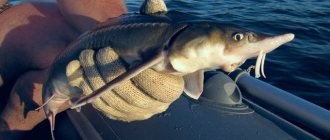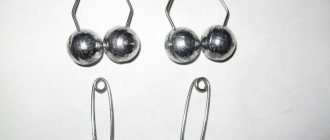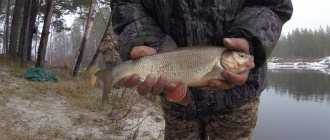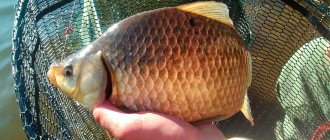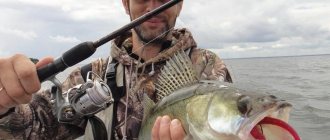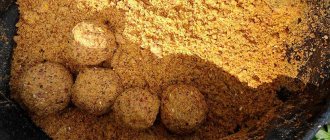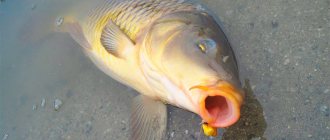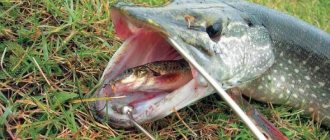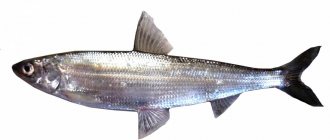Garland for winter fishing
A garland for winter fishing is a very interesting piece of equipment that allows you to fish in several horizons of a reservoir at once. With its help, you can determine at what depth fishing will be most promising. In addition, when using a garland for winter fishing, the effectiveness of fishing increases significantly.
Very often in winter, fish disappear from the bottom layer. It doesn’t bite and that’s it. Many people think that there are no fish or they don’t want to bite. But in fact, it’s just that fish in winter often moves into the water column and feels wonderful there all winter, without sinking to the bottom at all, and sometimes even swims to the ice. At the same time he eats. And, it is precisely for catching such fish that such tackle as a garland is used.
Garland for winter fishing is very widely used in certain regions of the former Soviet Union. She has a huge army of fans. Despite this, there are many, many winter fishing enthusiasts who have never even heard of such promising equipment for winter fishing as a garland. In this article we will look at how to knit a garland for winter fishing and what you need to successfully fish with it.
Catching perch with a garland
Date: January 29, 2021 | 871
You can catch perch with different tackles. These are fishing rods, donks, spinning rods with a wide variety of baits and equipment. There is such equipment, installation, as a garland. This equipment, as I see it, is especially relevant when catching schooling fish with predatory tendencies. In our reservoirs it is perch, and partly rudd. So, in this review I want to talk in more detail about such gear as a garland, and express a number of thoughts on the features of catching perch with its help.
So, let's imagine. A body of water, as a rule, has little current, or even standing water. In front of us is a vast area with a flat, uneven, but with a bottom clear of grass and snags. This could be a sandbar, a beach, or maybe a large window among the surrounding aquatic vegetation. And now, in this open space, a school of perch is causing mischief. You can catch perch with a regular jig, one by one. But sometimes they resort to such equipment as a garland. It involves several hooks, several silicone baits. This means you can catch several perches at once in one trip. Even with all the hooks for perch, if you're lucky.
It is clear that this is not sporting. The interest from such fishing may be the opportunity to catch more than a kilogram of fish... But, I know that many fans of edible fishing, microjig, are supporters of releasing the catch altogether. So, they don't need it.
Also, many are overcome by excitement. And they can be understood. It's fun to catch several perches.
Another point is that with the help of a garland you can quickly determine the preferences of local fish by the color and shape of the silicone. And to do this somewhat faster than simply going through and changing baits on a microjig.
An important advantage is the ability to throw and deliver very small silicone baits far, which, as a rule, are used with the lightest weights in microjig.
So, perhaps, I described the advantages, all sorts of advantages from fishing with a garland. Now, about the cons.
Actually, not sportiness. The tackle is more difficult to tie. Often confused. Although the number of hooks has been increased, the fishing rate has been reduced. While you remove the trash from the hook, while you remove the fish, while you untangle it, if anything. Little things, but the pace of fishing with a light jig with one bait is noticeably higher. Also, one of the disadvantages of this equipment is that you rarely find suitable conditions for this equipment.
So, we talked about the pros and cons. The possibilities of application in perch fishing were indicated. Now - materiel.
The garland is built on the basis of a spinning rod. An insert of thinner fishing line is tied to the main fishing line or cord, on which the garland is knitted. At the end of this piece of fishing line, a rather substantial weight is tied. Throughout the segment, 3-4 leashes are tied (I don’t recommend any more) with single hooks, onto which various silicone baits are put. Here is the scheme. Now, in more detail.
The spinning rod for the garland is taken quickly in order to better feel the wiring, bites, and guide the tackle more consciously. The spinning test should be considerable, because... Very light weights are not used in garlands. Usually, this is from 8-10g and above. The rod is taken quite long to make it more convenient to manipulate the tackle.
The coil is taken of medium size 2000-3000. The main fishing line, or better yet the cord, is not very thick. The place is clean, perch over 1.5 kg is extremely rare. So, there is no reason to fish with ropes.
An insert made of fishing line or fluorocarbon may not be very thin. Here we need to find a balance between invisibility and some rigidity. If you make an insert from a very thin fishing line, there will be a lot of confusion and overlaps. So, as a stiffer, 100% fluorocarbon, say in the 0.18-0.25mm range, would be a normal choice.
The sinker when fishing with a garland can be of any shape. You can at least tie a piece of lead. But, it is better to use something streamlined or flat. For example, a sinker from a donkey, or something like that. But the presence of an anti-twist will be a good addition if you are planning to do a lot of fishing with a garland.
You can use different baits for fishing with a garland Silicones can be edible or regular. Most often, small twisters are used, from 1” to 2.5”. You can also use other types of silicone, either passive slugs, or worms planted using the weck method, or in the usual way, by the edges. But, if you use passive fishing, you will have to give more twitches and pulsations to the gear than when fishing with small vibrotails or twisters. The trick of the garland is to use several different colors at the same time, and compare the result, change, experiment, and select the best solutions at that particular moment.
In addition to small silicone, I have come across that perch was caught on a garland using streamers made of goat hair. So, experiments in this gear can be carried out beyond the scope of application of silicone baits.
There are several options for tying a garland, tying leashes, hooks. Here are some of them.
The simplest option, without any additional leader material at all. Knitted directly from the insert line. The principle is the same as when making tyrants, which are used to catch smelt at sea, etc. A double knot is tied on the ring of the hook. This is how we fix the hook. And, then, we grab the fishing line on both sides. We form a double leash. And tie another double knot. The result is a leash made from double fishing line. It is important that during the knitting process the parts of the leash come out identical, without distortion. And the leash itself should not be very long. No more than 10cm. Usually twice as long.
You can use a slightly thinner fishing line or fluorocarbon than the insert material. We knit a loop on the fishing line, securing it with the same double knot. And we form the same loop at the end of the leash. We fasten the leash using the “loop to loop” or “noose loop” method. And at the other end of the leash we tie a hook with bait.
Another option is to tightly tie the leash to the insert line. There are quite a lot of options for nodes that can be used to implement this. I won’t describe it now. Somehow I’ll publish a separate article on how to tie a lead leash to the main fishing line.
Also, this method can be diversified by tying the hook not tightly, but in a loop, so that the bait has more freedom. Usually they resort to this if they use passive silicones.
And, another original method to form a garland. Just tie loops on which hooks with bait will move freely.
Here are the ways to tie a garland.
Share with your friends:
Categories: Fishing for food · Tags: Garland, Places, Installation, Perch, Tackle, Equipment
Fishing rod
Due to the fact that using a garland, you often have to move around the reservoir and the tackle is quite long, moving from hole to hole, all the tackle needs to be somehow carried. In this case, as a rule, his hands are not free, since the fisherman has a lot of other things (pick, drill, echo sounder). Naturally, it is much more convenient to carry coiled tackle. That is why reel fishing rods are used for fishing with a garland. When moving from hole to hole, the fishing line with devils or jigs is wound on the reel.
If there is no reel, then you should buy a piece of pipe insulation from a hardware store, cut off a little and wind the tackle around it, moving from hole to hole.
Tackle and equipment
As a rule, the weight of the fish caught when fishing with a garland in winter is small (no more than 1 kg), so the model and design of the fishing rod does not play a special role. If the goal of your fishing is a more serious fish, then you should take a more reliable fishing rod.
Read! Catching asp in winter
The length of the nod can reach up to 20 cm. It should be moderately rigid and have an inclination angle within fifteen degrees. Most fishermen choose flat, adjustable steel nods.
The line should not be very thick. Yes, it is stronger, but the action of the bait will not be as expressive, the fish will be scared of it, so 0.15 mm is quite suitable.
The preferred models of jigs are: “Devil”, “Uralka”, and “Ant”.
It is recommended to tie jigs without knots, for which the required piece of fishing line is unwinded, threaded into the loop of the bait, and drawn through the entire length. All that remains is to wrap the tip around the thread over the bait several times, pass it into the eye of the hook, and at the same time stretch the place of the winding.
Nod
Therefore, long nods are used for the garland. In 90% of cases these are nod hand makers. More effective are nods that are made from a clock spring, since these conical clock springs are quite stiff.
Please note that the lower jig weighs from 3 to 6 grams. In this regard, the nod should be moderately rigid so that under the weight of the jig it does not bend to death, but still continues to work. Not every nod can withstand the weight of such a jig. It’s also a plus that devils or jigs will be added here.
Most often, nods are made under a certain weight, but there are also nods with changeable stiffness. Such nods are spring-loaded by another plate. But if you pull out one of the plates, it becomes softer. That is, on such a nod it is possible to adjust the weight of the lower jig. For example, on a still body of water when fishing in the upper layers, you can use a light garland. During currents, it is advisable to use a heavier garland and, accordingly, a stiffer nod.
Coil
In addition, the reel must have a smooth ride and good friction. Although there is no clear opinion about its use. Still, when biting, excessive noise attracts the attention of other fishermen.
But on the other hand, when using it, it is possible to compete with large fish. The tackle will definitely not break during hooking.
Therefore, it is better to spend money on a garland once and buy a normal, correct coil. After all, they live a long time and normal coils are really not afraid of frost, nor are they afraid of falling from a great height onto ice.
fishing line
There is an opinion that the thinner the tackle, the more bites. It is true, but you need to maintain balance in the garland. If you reel in a line of 0.10-0.12, then in addition to the fact that there will still be a lot of breakages on large fish, most importantly, the tackle will get tangled. Why? Yes, it’s simple: when biting, all tackle more than 10 meters long with several devils or jigs will be scattered on the ice.
Naturally, the likelihood of it becoming entangled is very high, and there are often cases when a caught fish can jump on the tackle, entangling it even more. There is still a chance of untangling a thicker fishing line, since it is more rigid. There are no options on 0.12 line. Perhaps there will be more bites, but the time spent on untying, untangling or simply tying the tackle, because it is impossible to untangle it, will be spent many times more.
Therefore, it is recommended to use a fishing line with an average diameter of 0.16-0.165. When catching large fish in muddy water (although in winter the water is usually clear, but there are nuances), you can set it to 0.18. This is probably already criminally thick, but possible for use, and the thinnest is probably 0.14-0.15. This is the minimum for use in an ice fishing garland. And so it will peck and there will be more than enough bites if everything is done correctly.
Jigs or devils
For fishing with a garland, you can use either jigs or devils. Let me remind you that a devil is a painted three-piece with some kind of braid on which a cambric is worn, or something else. That is, in essence, it is a threesome that attracts fish.
The most universal colors of lures for winter fishing are black, red and their combinations. Dark green, brown, brown, and burgundy work very well. Sintz really likes lilac jigs. But the rest of the fish were absolutely indifferent to them. But red and black fish are interested in almost all types of peaceful fish.
Biting and fishing
Finally, the long-awaited bite occurred. Hook, but make sure the line always remains taut.
Tip: the fishing line should swing to the side, but strictly in the direction of the wind.
Pull the fish out carefully, trying not to catch the line on the edge of the hole. Don't rush, don't make noise, don't fuss, otherwise you will alert or scare away a school of fish. When fishing with a garland, it is important to constantly improve, and then a positive result will not be long in coming.
Read! Fishing for perch on the first ice
How to make a garland for winter fishing from jigs
It is very difficult to knit jigs into a garland in the usual way due to the large length of the tail, which will need to be pulled through each time you tie the jig. This is a super complicated option. Therefore, there are two options to simplify knitting a garland:
Option for mothless
Knitting a garland of jigs is exactly the same as knitting a garland of little devils. This method is only suitable for wormless jigs, so when used with this method of tying a bloodworm, there will be many empty bites due to the vertical position of the jig.
Option for fishing with bloodworms
To fish with a garland of jigs and bloodworms, you can use the following method:
And why did we do this? Only so that our jig is located at the desired angle, namely, so that the bloodworm is higher. At the same time, the number of idle bites will decrease significantly.
With this method of knitting a garland there is no knot at all, which is also a significant advantage.
Fishing with a garland video
Fishing in winter with a garland video on the Dnieper Bay. Catching bream, roach and silver bream in holes in the water column using a garland of jigs. Fishing technique. Tackle. Search for a working fishing horizon.
How to knit a garland of devils
Fishing with a garland video
Tackle garland for fishing in winter video
Description of the “garland” tackle made from jigs for catching white fish in winter in holes in the water column. Types of fishing rods, nods, fishing line, types of jigs and their correct placement on the fishing line.
Distance between jigs or devils
When knitting a garland for winter fishing with your own hands, the question often arises: at what distance from the bottom jig should I knit the remaining jigs or devils?
Two points are important here. If this is a search garland with which you are looking for fish, then the distance can be somewhere up to a meter. If you have a small pond with a depth of 2-2.5 m and a pool of up to 6 m, then of course a large garland is not needed. Then you should knit at a distance of 50 cm from each other.
The most optimal distance is about 70 cm. This is the height to which the tackle rises during the game. Even if fishing occurs while sitting on a chair, they still fish this way, although it is much more convenient to fish while standing with a garland. This way, fishing while standing turns out to be much larger, and it’s easier to find fish.
Choosing the optimal fishing depth after biting
Sooner or later the bite will happen. It is important to remember which bait along the horizon the bite occurred on. If the bite occurred on the lower jig, but the tackle is not at the bottom, then you need to rewind the line lower to cover the bite horizon and check the lower layer of water for the presence of fish in it.
When biting on the top jig or devil, you need to reel a few meters higher. And make the wiring higher. Perhaps the main school of fish is above the bait. Thus, you can get into the thick of the school and not just one bait can be in the zone of the school of fish, but two or three.
But there is an alternative, when the top bait is lowered to the horizon of the fish. This is done so that when fishing, you do not cling to the ice with baits that are higher than the one that was bitten.
For example, when biting on a medium bait, which, say, was at a depth of 6 meters, you should fish at such a depth that the topmost devil or jig was exactly 6 meters. The bites will be on him. And when you bite, a fish will immediately appear from the hole, and not four or five devils or jigs that often cling to the ice.
Features of finding fish when fishing with a garland
Naturally, it is very difficult to look for fish alone and without an echo sounder. Even having found a hole with fish, after several successful retrieves the school can move away. In which? It is unknown in which direction the fish moved.
Of course, there are times when the flock stands still, but they are very rare. And the likelihood of being alone on the ice, and even with fish, is also extremely small.
In general, it is very convenient to look for fish for a garland when there is a company of several fishermen, or better yet 5-6. Everyone is looking along the horizons in different places, one found - others surrounded him. Therefore, when fishing with a garland, it may seem that many fishermen are a minus. But on the other hand, in the absence of an echo sounder, from their actions, with little experience, it is clear where the fish are concentrated, what kind of fish and where it is moving.
Source
Tips for fishing with a garland
Experienced fishermen knit a garland with balanced jigs of the same type. But for beginners, it is recommended to use jigs of different weights and install them as follows: the heaviest one at the bottom, and then up - in descending order. That is, the last top jig will be the lightest. Why is this being done? This type of gear makes it much easier to find the bottom. In addition, this will reduce the chances of pulling out a tangled lump from the hole, which often happens when fishing with several jigs. By the way, you shouldn’t knit them close to one another either; the best interval is considered to be from 20 to 50 cm.
